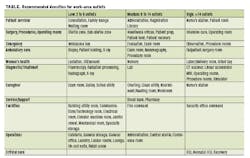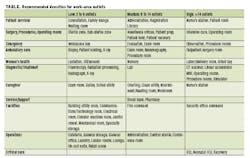Planning communications infrastructure for a healthcare facility
Standards and guidelines prescribe approaches to deploying and maintaining cabling and wireless systems for healthcare environments.
For professionals in the information and communications technology (ICT) industry, planning and designing a communications infrastructure that serves a healthcare facility requires up-to-date information on user needs, best-current practices, and to the extent possible, foresight into some of the facility’s future needs. For those embarking on a project of this kind, documents and resources are available as guideposts.
BICSI and the Telecommunications Industry Association (TIA) both have produced standards addressing ICT systems for healthcare. BICSI’s standard—titled ANSI/BICSI 004-2012 Information Technology Systems Design and Implementation Best Practices for Healthcare Institutions and Facilities—was published in 2012 as its document title indicates. The standard is currently under revision. On BICSI’s website, the association explains the realities that gave rise to the standard’s development and publication. “Healthcare design can be complex, due to the number and variety of systems, operational spaces, and additional regulations specific to healthcare,” BICSI says. “Today’s modern hospital includes areas analogous to residential, commercial, general office, industrial environment, all of which require not only the traditional phone and network connectivity, but additional systems such as security and building support, data and record archive and retrieval, specialized communication (e.g., nurse call), all of which have additional security requirements governing access, encryption, and even physical location.” BICSI adds that the standard was developed “to provide guidance on the issues specific to the healthcare environment. Written for the wide variety of facilities including hospitals, outpatient clinics and skilled nursing facilities, this standard covers not only common telecommunication and IT infrastructure concerns, but specific healthcare systems such as nurse call, interactive television/hospitality systems and connected medical imaging.”
As BICSI does with several of its standards, it makes a multiple-chapter sample of ANSI/BICSI-004 available on its website. In that sample document is further description of some digital dynamics in the healthcare industry. The standard states, “Today’s healthcare facilities are encountering many issues due to rapid changes in medical technologies, rapid changes in information technologies, an aging nursing workforce and patient demographics. Industry initiatives are also a key factor in the need to upgrade or replace the built electronic infrastructure, such as electronic health record, patient portable (personal) health record, electronic security, clinical and information technologyconvergence.”
TIA-1179 series
The TIA standard addressing healthcare environments is ANSI/TIA-1179-A Healthcare Facility Telecommunications Infrastructure. The “A” at the end of the standard’s numerical designation indicates it is the first revision of the standard. The original 1179 standard was published in 2010; the revision was published in August 2017. In its Standards Informant blog, Siemon describes the 1179-A standard as one that provides “specifications for the planning and installation of a structured cabling system for healthcare facilities and buildings. Included are requirements for cabling, cabling topologies, cabling distances, pathways and spaces (e.g. sizing and location), and other ancillary requirements. Guidance on selection of media and network design is provided and of particular importance for larger healthcare facilities, which may have a useful life far longer than traditional office-oriented commercial buildings.
“In addition to IT systems, the structured cabling specified by this standard is also intended to support a wide range of clinical and non-clinical systems such as non-IP and IP-based RFID, BAS [building automation systems], nurse call, security, access control, and pharmaceutical inventory.”
The table within this article, reproduced from the TIA-1179-A standard, includes recommendations for work-area outlet densities in different parts of a healthcare facility.
Also in the Standards Informant, Siemon lists the following specifications of ANSI/TIA-1179-A that differ from the original 1179 document.
• Minimum Category 6A cabling is specified for use in the horizontal and backbone cabling systems.
• Minimum 850-nm laser-optimized 50/125-micron OM3 is recommended for use in the horizontal and backbone cabling systems.
• Multimode and singlemode optical fiber cabling shall support at least 2 fibers.
• Array connectors are now permitted for optical fiber cabling in the work area.
• The minimum size of the telecommunications room has been increased to 16 m2 (170 ft2) or larger.
• Additional requirements for pathways and spaces, bonding and grounding, firestopping, support of broadband coaxial cabling, and multi-tenant building spaces have been added.
• Additional recommendations for wireless access points and distributed antenna systems have been added.
Wireless in healthcare environments
That final point about wireless systems reflects a growing emphasis on wireless in these types of facilities. Bree Murphy, RCDD, applications engineer with Oberon, has delivered a presentation titled “Practicalities of Deploying Wireless LANs in Healthcare.” In the section of that presentation called “How wireless is transforming the healthcare industry,” Murphy describes several drivers of demand for high-bandwidth wireless LANs in these facilities. A few of those drivers are growth in wireless healthcare apps, the use of handheld mobile devices by clinical technicians, wireless connectivity being built into medical devices (like infusion pumps, beds, and monitors), wearables, and real-time location systems.
Murphy also emphasized that a number of mobility technologies are now commonly used in healthcare environments, including telemetry, Bluetooth, cellular, wireless LAN, RFID, and ultra wide band (UWB), which is a low-energy, short-range communication technology. In general, more devices in medical settings are transitioning from proprietary networks to the wireless LAN or WiFi network, thereby driving the need for a more-robust, more-accessible WiFi network.
“Designers will face new challenges in wireless design and deployment,” Murphy said, citing network capacity, scalability, device coexistence, mobility, and power consumption among those challenges.
She then explained that ICT professionals can consider “grades” of wireless services in a hospital. She described the grades as follows.
Medical grade/life critical—Support clinical devices and apps to collect and share life-critical medical info
Enterprise grade/mission critical—Support health devices and apps that inform and direct
Consumer grade/inform—Wireless service that supports consumer devices and apps to inform
All grades of service, Murphy pointed out, require a robust wireless system that is ready for future technologies, quick upgrades, and in some areas, redundancy.
Guide to the wireless utility
In several places Murphy’s presentation cites the document “Guide to Medical Grade Wireless Utility” (GMGWU). Published by BICSI in 2015, the GMGWU is a companion document to the BICSI 004 standard as well as to ANSI/BICSI 006-2015 Distributed Antenna System Design and Implementation Best Practices. The GMGWU states, “The new paradigm for wireless design in healthcare facilities should include a disciplined design approach. The medical grade wireless utility brings an engineered process-based approach to wireless network design andimplementation.”
The GMGWU characterizes and discusses four types of networks in medical environments. The wireless clinical data network (WCDN) is “a logical network that uses the physical assets of the broadband (DAS), WLAN and possibly other networks to carry its traffic,” the document says. “It includes both licensed and unlicensed radio frequency bands and is used for medical devices providing life-critical continuous monitoring.”
The wireless local area network (WLAN) is “a physical network which includes the use of unlicensed frequencies in a manner that is intended to be used within the facility and adjacent grounds … A layered WiFi architecture is a key element of the medical grade wireless utility.”
The wireless wide area network (WWAN) is “a physical network which includes those wireless services that are intended to work both inside and outside the facility. Services could include cellular, paging, life-safety radio, and two-way radio.”
The location local area network (LLAN) is “a logical network [like the WCDN] that uses the physical assets of the other networks and technologies for its traffic. It is used to locate people and assets within the grounds of the facility.”
A section of the GMGWU called “Implementation” covers design challenges, cross-functional teams, planning, and implementation testing. In its conclusion, the document states, “Design and implementation of the medical grade wireless utility is a process that takes thought, engagement across hospital departments, and a desire to implement an effective wireless infrastructure. Medical grade wireless utility can prepare the hospital for the changing healthcare IT environment, future wireless technologies, and enable a mobile care model inside of the hospital. It will add to the efficiency of clinicians and employees across the
About the Author
Patrick McLaughlin
Chief Editor
Patrick McLaughlin, chief editor of Cabling Installation & Maintenance, has covered the cabling industry for more than 20 years. He has authored hundreds of articles on technical and business topics related to the specification, design, installation, and management of information communications technology systems. McLaughlin has presented at live in-person and online events, and he has spearheaded cablinginstall.com's webcast seminar programs for 15 years.


